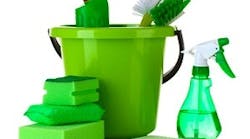Sustainable and Effective Cleaning Practices Lead to Cost Savings
Green and sustainable cleaning practices are among the key drivers in the commercial cleaning industry, and show no signs of slowing down. Customer demand and the accompanying surge in environmentally preferable products and services is impacting the way facility managers think and approach the cleaning and maintenance of their buildings. But, does this focus on sustainability come at the expense of the bottom line?
The past ten years have brought tremendous growth in the awareness of green cleaning, and the widespread adoption of green cleaning programs and practices. A recent survey by ISSA, the worldwide cleaning industry association, and Sanitary Maintenance Magazine of commercial cleaning product distributors reported that almost one-third of total sales were for “green cleaning products,” including a wide variety of products such as chemical cleaners, powered cleaning equipment, paper and plastics, supplies and other janitorial tools. In addition, a recent Contracting Profits Magazine report indicated that 83% of contract cleaning service providers had or will soon offer green cleaning services and that 43% of customers are specifically requesting sustainable cleaning practices be used in their facilities. The push for sustainable cleaning has even led to 22 state governments instituting some type of green cleaning procurement program.
”Green” products and practices have clearly helped facilities lower their impact on the environment. For example, facility managers have been able to reduce the health impact on both cleaning service workers and building occupants, reduce waste by incorporating a comprehensive recycling program, lower energy consumption and conserve water by investing in a variety of new technologies, including low-flow toilets and sinks, innovative cleaning equipment, and new plumbing systems that are capable of recycling water.
While the environmental benefits are clear, there is often the notion that sustainable cleaning and green products come with a high cost. However, a growing body of evidence has documented that comprehensive green cleaning programs, in addition to sustainable building practices, have led to significant savings on energy, water, chemicals and waste, while reducing illness and injuries to custodial staff as well as workers’ compensation costs.
The University of Georgia’s (UGA) Physical Plant Division - Services Department is a shining example. UGA has successfully implemented an innovative process improvement focused on green cleaning, environmental purchasing, and workplace safety, using the Cleaning Industry Management Standard-Green Building program (CIMS-GB) as a road map. The quantifiable benefits have been documented by the University:
- After the implementation of these programs, UGA found that the number of cleaning service worker injuries decreased from 39 in 2006 to only 17 in 2009, while lost worker hours decreased from 4,474 to 386 over the same time period.
- The University was able to decrease its expenditure on chemical products from $1.5 million to $110,000 annually, due to its new environmental purchasing policy.
- Ultimately, the university estimates a total savings of $850,000 during the 2008 and 2009 fiscal years.
Other facility managers have enjoyed a cost benefit when switching to “day cleaning” – where cleaning activities are performed during the daylight hours rather than at night – a cost benefit specifically resulting from reduced energy use. By choosing less hazardous cleaning products, facility managers can reduce exposure, minimize the potential impact to custodial workers and building occupants, improve indoor air quality and reduce water and ambient air pollution. Since many green cleaning practices call for greater dilution of cleaning products, there may be a reduction in packaging waste and disposal costs of hazardous cleaners. Many facility managers have also found green cleaning practices reduce wear and tear on facility assets, increasing their lifespan.
Sustainable and effective cleaning processes can be a critical component to helping buildings function with greater operational and financial efficiency. By better understanding the value of green cleaning, operations and maintenance teams can leverage sustainability to improve overall health and cleaning efforts, reduce costs, extend buildings’ longevity, and, ultimately, have a positive impact on the bottom line.
Dan Wagner is Director of Facility Services Programs for ISSA. Dan can be reached at [email protected]


